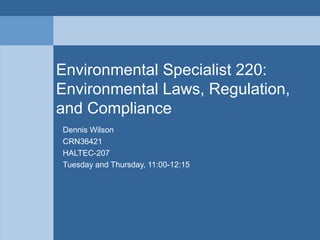
Introduction to Environmental Law
- 1. Environmental Specialist 220: Environmental Laws, Regulation, and Compliance Dennis Wilson CRN36421 HALTEC-207 Tuesday and Thursday, 11:00-12:15
- 2. Introduction • Three branches of government • Process for passing laws • Judicial Review • Executive branch rulemaking powers
- 4. Article I, Section I of the U. S. Constitution “All legislative Powers herein granted shall be vested in a Congress of the United States, which shall consist of a Senate and a House of Representatives.”
- 5. U. S. Senate • 100 members • 2 from each state • U. S. Vice President is the President of the Senate • Run by the Senate Majority Leader • Minority Leader leads the opposition party • Legislative Committees
- 6. House of Representatives • 435 Members • Districts are proportional based on population • Run by the Speaker of the House • Also has a Majority Leader • Minority Leader leads the opposition party • Legislative Committees
- 7. Federal Legislative Process • Member of Congress Introduces a bill to either House or Senate. • Referred to committee/subcommittee • Committee holds hearings • Bill is “marked up” • Subcommittee votes
- 8. If the subcommittee approves • Forwarded to the full committee • Committee may approve, hold, or reject the bill • If approved, it moves to the full House or Senate • Bill may be amended at any stage in this process • Repeat in the other chamber
- 9. Reconciliation • Usually, House and Senate versions of a bill have differing language. • Senate-House Conference Committee reconciles the bill. • Both chambers approve the final version.
- 10. President’s Signature • Once passed by both chambers, the bill goes to the president for signature. • The president can sign, veto, or do nothing. • If the president does nothing, the bill becomes law after 10 days, unless Congress adjourns. – Pocket Veto
- 11. Laws Passed by Congress • Becomes a statute • United States Code • United States Code Annotated • http://uscode.house.gov/
- 12. Scoring Your Representative & Senator • League of Conservation Voters • http://www.lcv.org/scorecard
- 13. Pennsylvania General Assembly • Mirrors U. S. Congress • Senate: 50 members • House: 203 members • Both represent districts based on population • https://govt.westlaw.com/pac/index? __lrguid=id1dd3412fdb24c769172f4f cd5c6dbd1&transitionType=Default& contextData=%28sc.Default%29
- 14. Lobbying • Lobbyists meet with legislators in order to influence the process. • Most are paid professionals • Some are volunteers
- 15. Industry Lobbyists • Energy Sector spent $225 million lobbying in 2008 • Open Secrets
- 16. Environmental Groups • Spent $11 million in 2008 • Moderate: Environmental Defense Fund and Defenders of Wildlife. • More extreme: Earth First! • Open Secrets
- 17. Environmental Lobbying Organizations Businesses Environmentalists Business Roundtable Environmental Defense Fund Chemical Manufacturing Association National Audubon Society National Environmental Development Council National Resources Defense Council National Chamber of Commerce Sierra Club Utility Air Regulation Group Wilderness Society
- 18. Hydraulic Fracking • Method for drilling natural gas • Exempt from many environmental regulations • Industry lobbyists spent nearly $750 million over the last decade.
- 19. Citizens United • Citizens United v. Federal Election Commission. • 2010 Supreme Court Decision • Lifted many federal restrictions on corporate spending.
- 20. Citizens United • Companies and unions can spend unlimited amounts to influence elections. • 72% of political advertising spent in 2010 were from sources that were prohibited in 2006.
- 21. Judicial Branch • Article II of the U. S. Constitution creates the federal Court System and the U. S. Supreme Court. • Creates case law or common law. • Law of Precedent
- 22. Courts Interprets Law • “Plain Language” of the statute. • Legislative Intent as found in the Congressional Record • Statutes are often written broadly. • Courts must apply them based on specific situations
- 23. Stare Decisis • “Let the decision stand” • Common law guides decisions based on precedent. • Every case is unique. • When does precedent apply
- 24. Judicial Review • Marbury v. Madison 1803 • Supreme Court can declare a statute unconstitutional • Supreme Court can also overrule precedent and invalidate previous rulings
- 25. Executive Branch • President • Cabinet – Heads of all executive departments • Office of Management and Budget • Office Personnel Management
- 26. Treaty • President can enter into treaties with the “advice and consent of the Senate.” • Once ratified by the Senate, a treaty becomes the supreme law of the land. • Supersedes state laws • Montreal Protocol – Phased out CFCs
- 27. Executive Orders • Issued by the president • Order federal agencies to follow policy • Clarifies how laws are to be implemented.
- 28. EOs are easy to do, but . . . . • Can also be easily rescinded by the next president. • Temporary victories • Recently have become politically contentious. • e. g. President Obama’s EO on immigration
- 29. Signing Statements • Attached to bills by the president • Often used to dilute laws instead of vetoing them. • President declares which parts will not be enforced. • Which parts he believes are unconstitutional
- 30. Administrative Agencies • EPA • OSHA, etc. • Congress has delegated authority to these agencies to adopt regulations
- 31. Regulations • Are laws • Based on statutes passed by Congress • More detailed than statutes • Federal Regulations: ecfr.gov • Pennsylvania Regulations: pacode.com
- 32. Regulatory Process • Done by unelected officials • Open to public participation and scrutiny • Proposed rules are published in the Federal Register. • Proposed PA rules are published in the PA Bulletin. • Final rules are also published before adoption.
- 33. Conclusion • Three branches of government • Process for passing laws • Judicial Review • Executive branch rulemaking powers
